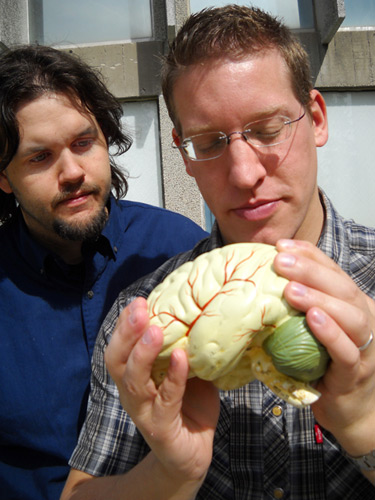
Ask someone to close their eyes and hand them an unfamiliar object. Allow them to handle it for a moment. Take back the mystery object and place it alongside another item. Now ask your friend to look at both objects and pick the mystery item. Chances are he or she will get it right ― but how?
A study by Guelph researchers published this month in the Journal of Neuroscience may help explain how the brain processes different kinds of perceptual information. The study by psychology professor Boyer Winters and master’s student James Reid may also hold clues for understanding what goes awry in people with dementia and other brain disorders who are unable to recognize familiar objects or people.
Intrigued by how the brain makes sense of complex stimuli, they tested rats’ ability to recognize objects by touch using only their paws and whiskers. In an experiment, Winters and Reid placed identical objects at either end of a Y-shaped apparatus and allowed rats to explore under red light (rats cannot see in red light). The researchers repeated the experiment with a new object in one of the arms of the apparatus. During that choice phase, the rats spent more time investigating the new object.
Winters and Reid saw the same results when they tried the test under ordinary light but inserted transparent barriers to allow the rats to see the objects without touching them. Again, the rats “selected” the new object during the choice phase.
Finally, they tested the rats first for touch only and then for sight alone in order to see whether the animals could recognize objects across those senses. Their paper shows for the first time that rats can visually recognize items that they had earlier only touched with their paws or whiskers.
“That’s what is so cool. I didn’t think they’d be able to do it,” says Winters.
But how did they do it?
Specialized areas of the brain mediate information processing for sight and touch, including the perirhinal cortex for vision and the posterior parietal cortex for touch. Some researchers believe the brain integrates information from those senses elsewhere to recognize objects. Others believe these specialized brain regions “talk” directly to each other without representing objects somewhere else in the brain.
To learn more, Winters disrupted areas within rats’ brains for touch and sight. Rats with impaired sight recognized objects by touch alone. But they couldn’t visually recognize the objects. The reverse occurred in rats with impaired touch. In neither case could rats use tactile information to recognize a visual object.
“It looked like both uni-modal areas contribute to cross-modal object recognition,” says Winters.
To learn about possible cross-talk, he disrupted connections between the brain’s touch and sight areas. Those rats could recognize objects based on either sense but not across senses.
“The perirhinal cortex and the posterior parietal cortex need to work together as part of a functioning unit,” says Winters. “Maybe they project somewhere else in the brain or talk to each other.”
He and Reid plan further experiments to learn more about which model is correct. Meanwhile, their research has already provided more information about the workings of memory, which is the Guelph scientist’s main interest.
Much past research has looked at relatively localized memory processing, especially in the brain’s hippocampus. Pointing to the areas tested in his rats’ brains, Winters says the more likely model is a distributed system. “Memory, especially more complex memory, requires integration of information processing across specialized brain regions, not just one brain region.”
He says object recognition is an important part of memory ― so important that doctors use object recognition tests to help diagnose forms of dementia. “That’s one type of information that goes first in Alzheimer’s patients.”
Reid began his master’s last fall. He completed a psychology BA last year; he switched majors from computer science after having encountered neuroscience courses.
“When we take pains to understand piece by piece the internal workings of the brain, we are not merely studying how the brain processes information as a masterwork of biological computing,” says Reid. “We are trying to understand what it is to be human.”